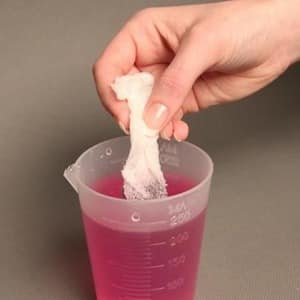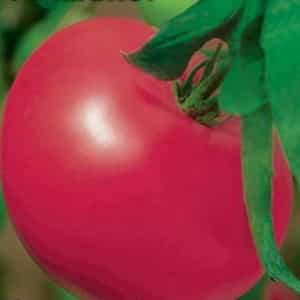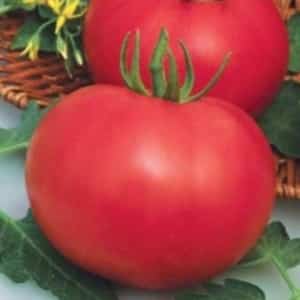A mid-season variety with fruits, just like in the picture - the “Major” tomato and instructions for growing it in open and closed ground
Tomato Major f1 is the result of long-term crossings of many varieties. The resulting hybrid received a lot of favorable reviews. There are more and more people wanting to plant it in their garden beds. Pink tomatoes have a high content of nutrients and microelements.
The excellent presentation of the fruit is conveyed by the colorful photographs presented in this article. And the excellent taste will not leave even the most sophisticated gourmet indifferent.
Description of the hybrid
The f1 hybrid was bred in Russia and entered into the State Register in 2009. It was originally created for cultivation in greenhouse conditions, but in the southern regions it is successfully bred in open beds.
Distinctive features
Indeterminate bush, height up to 2 m, dense foliage, large leaves, similar to potato leaves, simple inflorescences. The ovaries form 2 months after sowing the seeds.
The species is mid-season, 110-115 days pass from planting to full ripening. Fruiting in open beds is extended, until frost.
Productivity is high, from 1 sq. m, up to 6 kg of fruits are collected, provided that up to 8 seedlings are planted per 1 sq. m. m.
The genes of the hybrid contain high resistance to diseases of the nightshade family.
A tall crop requires obligatory garter and regular stepsoning. Immediately after transplantation, the bushes begin to quickly grow green mass, so they are planted from an early age.
Fruit characteristics
The weight of ripe vegetables ranges from 150-300 g; as a rule, the first fruits are larger. The shape is round, the color is pink glossy, the flesh is juicy, there are 6 seed chambers. The taste is sweet, with a slight sour taste.

The purpose in cooking is universal. Small vegetables are used for whole-fruit canning, large ones are used in pickles and marinades. But the best way to consume it is fresh.
Ripe vegetables are stored for a long time, perfectly maintaining their presentation. Due to these qualities, the crop is bred on an industrial scale for commercial purposes.
In the photo on the right is a Major tomato.
How to grow seedlings
Sowing of seeds begins 2 months before planting seedlings in the ground. The final dates are determined by the climatic features of the region. Before sowing, the seeds undergo the processing necessary to obtain high-quality seedlings.
Seed preparation
The seed material is carefully inspected for visible defects. Suitable grains must be light in color, without spots, visible damage or distortion.
To determine whether the seed is empty or not, they are placed in a saline solution for 10 minutes. The floating grains are discarded, the rest are washed with running water.
Next, the planting material is disinfected in a weak solution of potassium permanganate. To do this, they are wrapped in gauze and placed in the solution for 20 minutes.
After this, the grains are washed with running water and dried.
Reference! As a result of disinfection, up to 30% of seeds lose their viability. But this is not scary, since only viable specimens will germinate.
To improve germination, grains are soaked in a growth stimulator for 12-13 hours. Once the seeds have swelled, they are ready for sowing.
Container and soil
The soil is prepared from garden soil and humus in equal quantities.After thoroughly mixing the components, add a little mineral fertilizer to the mixture. The prepared soil undergoes mandatory disinfection by steaming in the oven at a temperature of 50° C for no more than 15 minutes. You can also water the soil with a hot solution potassium permanganate.
After disinfection, the soil is laid out in planting containers. You can plant in a common wooden box or in individual containers, peat and plastic cups.
Reference! There is no need to transplant seedlings into the soil from a peat pot; the container is placed in the soil along with the contents.
Drainage holes are made at the bottom of the planting containers, where excess moisture will drain.
To avoid picking, the seeds are sown in separate containers.
Sowing
The seeds are sown to a depth of 1.5 cm, sprinkled with soil on top and moistened the soil with a spray bottle. Then the containers are covered with film or glass to create a greenhouse effect and left in a warm room at a temperature of at least 23° C.
Seedling care
After the first shoots appear, the containers are placed on the windowsill to receive the required amount of light. If there is insufficient natural light, the plantings are illuminated with phytolamps.
Watered moderately, using a shallow watering can or tablespoon, along the edge of the containers, with warm, settled water.
Important! When the soil becomes waterlogged, young roots will begin to rot.
 When 2-3 true leaves appear, the seedlings dive, planting them in separate containers. If the seedlings remain in a common box, the distance between the sprouts is increased to 10 cm. Healthy and strong sprouts are planted, weak plants are disposed of.
When 2-3 true leaves appear, the seedlings dive, planting them in separate containers. If the seedlings remain in a common box, the distance between the sprouts is increased to 10 cm. Healthy and strong sprouts are planted, weak plants are disposed of.
Picking helps to select high-quality seedlings.
2 weeks before planting the seedlings in the ground, they begin to harden off.Hardening involves staying outside initially for no more than 1 hour. Gradually this time increases to 14 hours.
How to grow tomatoes
After 2 months, the seedlings are ready to be transplanted into the ground. By this time, the bushes have at least 5-6 true leaves, and the plant has a developed root system. Transplantation into open ground is carried out 2 weeks later than in a greenhouse.
Landing
Before transplanting, tomato beds are treated with a hot mixture of copper sulfate and mineral fertilizers are applied. A little ash is added to the bottom of holes 20 cm deep and filled with water.
Replant on a cloudy day or after sunset. The tomato does not like direct sunlight, it will be more difficult for it to take root.
Planting pattern: 30 cm – distance between seedlings, 40 cm – between rows. For 1 sq. m place no more than 8 plants.
Further care for tomato Major f1
As young bushes adapt to new conditions, regular watering is established no more than 2 times a week. Do not forget that in rainy times the amount of watering should be reduced, and on hot and dry days, on the contrary, increased. Water at the root with warm, settled water, without flooding the beds.
Reference! Overmoistening of the soil provokes the development of fungal diseases.
After each watering, the soil is loosened and hilled up. These techniques not only promote better penetration of oxygen to the root system, but also become necessary preventive measures in the fight against many pests.
Feeding do three times per season: during flowering, during the formation of ovaries and during fruiting. Feed with a full complex of mineral fertilizers or organic matter. The culture responds well to the addition of mullein infusion in a ratio of 1:10.
During fruiting, potassium fertilizers are added to the fertilizing for faster fruit filling.
Reference! All fertilizing is applied after watering.
Features of care and possible difficulties
Tall bushes require obligatory staking not only of the stem, but also of the fruit-bearing branches. The branches are spreading; when the fruits ripen, they cannot withstand the weight of their weight and bend down to the ground. When contacting wet beds, the fruit begins to rot.
To secure the plants to the support, wooden stakes or metal rods are installed next to each bush, to which the plants are tied as needed.
Many shoots form on the bushes from an early age, which must be removed, otherwise unnecessary shoots will consume a large amount of useful substances.
When forming a bush with 2 stems, the maximum yield is obtained, but the resulting fruits have less weight. Nevertheless, entrepreneurs grow crops in this way for the greatest quantitative return.
Diseases and pests
Tomato variety Major f1 immune to dangerous diseases of the nightshade family, such as blossom end and root rot, powdery mildew. However, the risk of infection with cladosporiosis (brown spot) remains. Cladosporiosis is a fungal disease that mainly affects greenhouse plants. It is characterized by the appearance of yellowish spots on the leaves, which subsequently dry out and crumble.
Prevention of fungal diseases means moderate watering, loosening the soil and removing weeds with roots. The main thing is to prevent the soil from becoming waterlogged.
In greenhouse conditions, along with elevated air temperatures, ideal conditions arise for the development of fungal infections.The pathogenic environment is destroyed by a regular influx of fresh air, so closed structures are systematically ventilated, avoiding drafts.
In case of infection, broad-spectrum fungicides “Bravo” or “HOM” are used. Traditional methods use iodine with milk, dissolving 15 drops of iodine in 0.5 liters of milk. Then the resulting mixture is added to 5 liters of warm water and the resulting solution is sprayed on diseased bushes once every 2-3 days.
Dangerous insect pests include whiteflies, Colorado potato beetles, and aphids. For whiteflies and aphids, a soap-ash solution is used to treat the stems and branches of plants. The Colorado potato beetle is controlled with the drug “Prestige”.
The nuances of growing in open and closed ground
Initially, the hybrid was bred for greenhouse conditions, which allows tomatoes to be grown in all regions. If the greenhouse is heated, the tomato will bear fruit even in the coldest areas. But when bred in the south in open ground, the fruiting indicators turned out to be no worse than in greenhouses, so the hybrid began to be grown in open beds. Good returns are obtained in the Crimea, Kuban and Astrakhan region.
For 1 sq. m place up to 8 seedlings, so regular pinching is necessary from an early age. Plant density reduces the number of plants and leads to the spread of diseases and pests.
Before planting in the greenhouse, add a little sawdust to the soil. This not only adds lightness, but also retains moisture longer.
To limit the growth point of tall plants, pinch the crown, thereby stopping further growth.
If crops of the nightshade family were previously grown in the greenhouse, then the top layer of soil is changed before planting tomatoes.This way, young bushes will receive the nutrients necessary for growth and development.
Important. During ripening, cracking of the peel is sometimes observed in the fruit. This is due to waterlogging of the beds and excess fertilizing. To eliminate the cause of cracking, stop watering and fertilizing.
Harvesting and application
Fruit harvesting begins in June and, thanks to extended fruiting, ripe vegetables will delight you for several months. The longest period is in the southern regions. Vegetables are harvested only at the stage of full ripening, otherwise the taste characteristics noticeably deteriorate.
The purpose of ripe vegetables in cooking is universal.. They are great for fresh consumption; they are used to make salads, hot and vegetable dishes, and a variety of snacks. Ripe vegetables are fortified and contain a large amount of microelements, which makes them excellent juice.
Smaller tomatoes are used for canning. Large tomatoes are salted in a barrel. Any type of canning retains its taste properties, since the peel does not crack during heat treatment. The durable peel allows the tomatoes to be frozen.
Ripe vegetables can be stored for a long time and can withstand long-term transportation. This fact allows entrepreneurs to consider culture for commercial purposes.
Advantages and disadvantages
The positive properties of the hybrid include:
- possibility of breeding in all areas;
- adaptation to climatic conditions;
- ease of care;
- high resistance to diseases;
- high fruiting rate;
- excellent taste;
- marketable condition;
- versatility in cooking;
- possibility of breeding for sale;
- long-term storage;
- long transportations.
Among the negative properties are:
- the need for regular stepsoning;
- obligatory garter;
- the influence of plant formation on yield;
- cracking of the peel due to high humidity.
Farmer reviews
Favorable reviews from those who planted the hybrid do not allow us to doubt the reliability of the vegetable crop. Here are the opinions of gardeners:
Valentina, Orel: “I plant the hybrid in a greenhouse for two seasons. I formed the bush with two stems and tried it with three stems. The yield is stable, the tomatoes are tasty. Excellent for salads and pickles.”
Evgeniy, Krasnodar region: “Weather conditions allow us to grow tomatoes in the garden. The fruits of the first harvest are large. We use them for salad. Further, the ovary becomes smaller, but for preservation it is just right. This is not the first time I’ve planted a hybrid and I will plant it again.”
Conclusion
The hybrid does not have complex agricultural technology. Even a beginner in gardening will appreciate its high and friendly output. In addition, the Major tomato is immune to many diseases and adapts well to both greenhouses and open ground conditions in the southern regions.
The excellent taste of ripe vegetables and the preservation of their presentation for a long time enable entrepreneurs to use the hybrid for commercial purposes.